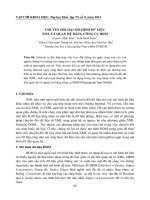HYDROTREATMENT HDS HDN HDO HDM
Bạn đang xem bản rút gọn của tài liệu. Xem và tải ngay bản đầy đủ của tài liệu tại đây (6.5 MB, 108 trang )
REFINING PROCESSING
HYDROTREATMENT
(HDS, HDN, HDO, HDM)
INTRODUCTION – SULFUR PROBLEM
INTRODUCTION – SULFUR CONTENT IN FUELS
Major Changes in Specification of Diesel and Gasoline
INTRODUCTION – SULFUR CONTENT IN FUELS
Diesel Fuel Standards
Region
NA
Europe
Sweden
Previous
500 ppm max
350 ppm
50 ppm (1990)
SA
China
Russia
500 ppm
2000 ppm
2000-5000 ppm
Current (2008)
15 ppm (2006)
50 ppm max, 10 ppm (2009)
2-5 ppm (2000) [5% aromatics]
0 ppm [1% aromatics] (2008)
50 ppm
500 ppm (only some areas)
350-500 ppm (only some areas)
INTRODUCTION
INTRODUCTION
Due to depleting supplies of quality petroleum crudes,
refineries world-wide are increasingly being forced to
use inferior quality heavy oils (HO) for producing clean
transportation fuels.
Unfortunately, the low grades HO are considerably
more difficult to process and can significantly reduce
the efficiency of clean fuels production.
From the viewpoint of continual efficient supply of
clean fuels, it is therefore critical to improve key HO
processes such as sulphur and nitrogen removal.
HDT
REFINING
Refining is the process, wherein, one complex mixture of
hydrocarbons is classified into a number of other complex
mixtures of hydrocarbons.
or
Petroleum refining is an important activity that the product at the
end of the process is a source of transportation and involves
heating of fuels and petrochemicals.
Increasing awareness of the impact of environmental pollution
by automobiles has shifted the responsibility of pollution control
to the refiner’s side.
PROCESSES IN REFINERIES
PROCESS
Catalytic
cracking
Hydrodesulfurisation
(HDS)
Hydrotreating
Hydrodenitrogenation
(HDN)
Hydrocracking
Hydrodeoxygenation
(HDO) and (HDM)
Catalytic
reforming
Hydrotreating: A process used in the oil industry to remove objectionable
elements such as nitrogen, sulfur, oxygen and metals from petroleum
distillates by reacting them with H2 over a catalyst.
Hydrodenitrogenation (HDN): is the removal of nitrogen from nitrogen
containing feeds in the form of NH3. The resulting products are
hydrogenated
Hydrodesulfurisation (HDS): is the removal of sulfur from sulfur
containing feeds in the form of H2S. The resulting products are
hydrogenated
Hydrodeoxygenation (HDO) and hydrodemetalization (HDM) are the
removal of oxygen and metals from the feed.
Hydrotreating has been extended in recent years to atmospheric resids to
reduce the sulfur and metal content of resids for producing low-sulfur fuel
oils. The operating conditions of treatment are a function of type of feed and
IMPORTANCE
HDS
HDN
Prevention of poisoning of the
Nitrogen containing compounds
metal catalysts by sulfur
Control
of pollution by SO2
produced in the combustion of
fuel
Removal of the unpleasant odour
of lube oil caused by the presence
of sulfur
severely reduce the activity of
cracking,
hydrogenation,
isomerisation, reforming and HDS
catalysts
High nitrogen concentrations are
detrimental to product quality
To
meet the
restrictions.
NOx
emission
If present, N-compounds affect
the stability of fuels.
HDT in refinery
HDT in refinery - common objectives and applications
Naphtha (catalytic reformer feed pretreatment)—to remove sulfur,
nitrogen, and metals that otherwise would poison downstream noble
metal reforming catalysts
Kerosene and diesel—to remove sulfur and to saturate olefins and
some of the aromatics, resulting in improved properties of the streams
(kerosene smoke point, diesel cetane number or diesel index) as well
as storage stability
Lube oil—to improve the viscosity index, color, and stability as well as
storage stability
FCC feed—to improve FCC yields, reduce catalyst usage and stack
emissions
Resids—to provide low sulfur fuel oils to effect conversion and/or
pretreatment for further conversion downstream
HDT in refinery
Feed types:
– Naphtha.
– Kerosene.
– Gas oils.
– Atmospheric resids or reduced crudes.
Principal impurities:
– Sulfur.
– Nitrogen.
– Oxygen.
– Olefins, Aromatics
– Metals
CHEMISTRY
The following chemical steps and/or reactions occur during the hydrotreating
process (depending on the impurities present):
Sulfur removal, also referred to as desulfurization or hydro-desulfurization (HDS) in
which the organic sulfur compounds are converted to hydrogen sulfide
Nitrogen removal, also referred to as denitrogenation or hydro-denitrogenation (HDN)
in which the organic nitrogen compounds are converted to ammonia
Metals (organo-metallic) removal, also referred to as hydro-demetallation or hydrodemetallization (HDM), in which the organo-metals are converted to the respective
metal sulfides
Oxygen removal, in which the organic oxygen compounds are converted to water
Olefin saturation, in which organic compounds containing double bonds are converted
to their saturated homologues
Aromatic saturation, also referred to as hydro-dearomatization, in which some of the
aromatic compounds are converted to naphthenes
Halides removal, in which the organic halides are converted to hydrogen halides
In general, the hydrotreating reactions proceed in the following descending
order of ease: metals removal, olefin saturation, sulfur removal, nitrogen
removal, oxygen removal, and halide removal. Some aromatic saturation also
occurs.
Thermodynamics and kinetics
Thermodynamics
– Hydrodesulfuration : no thermodynamic limitation
Reactions are 100% completed, all the reactants are converted
into products
Exothermic reaction
– Aromatics saturation: thermodynamic limitation
Reactions are in equilibrium, part of the reactants only are
converted; the amount of products and reactants at equilibrium
depends upon the operating conditions and is dictated by the
thermodynamics.
Kinetics: rate of reaction (i.e., the amount of feed that disappears per
unit of time); dependent upon operating conditions but can also be
widely modified through the use of properly selected catalysts. One
reaction (or a family of reactions) is generally enhanced by a specific
catalyst.
THERMODYNAMIC CHARACTERISTICS: Heat of reaction
Thermodynamics and kinetics
The sulfur compounds (mercaptans, sulfides, disulfides) are easily
hydrogenated into saturated or aromatic corresponding hydrocarbons,
with production of H2S. The reactions are exothermic
The nitrogen compounds are hydrogenated to saturated or aromatic
corresponding hydrocarbons, with production of NH3. The reactions
require higher H2 partial pressure and are exothermic
The hydrogenation of unsaturated hydrocarbons is characterized by an
important
heat
release
and
a
reduction
of
volume →
low temperature and high pressure favor these reactions .
The thermodynamics show also that, in opposite to aromatics, the
hydrogenation of diolefins is almost complete at 300°C with a low
hydrogen partial pressure.
The operating conditions result from a compromise between the above
thermodynamic considerations and the minimum temperature required
by the kinetics of the reactions.
THERMODYNAMIC EQUILIBRIUM OF AROMATICS HYDROGENATION
THERMODYNAMIC EQUILIBRIUM OF AROMATICS HYDROGENATION
Thermodynamics and kinetics
The sulfur compounds (mercaptans, sulfides, disulfides) are easily
hydrogenated into saturated or aromatic corresponding hydrocarbons,
with production of H2S. The reactions are exothermic
The nitrogen compounds are hydrogenated to saturated or aromatic
corresponding hydrocarbons, with production of NH3. The reactions
require higher H2 partial pressure and are exothermic
The hydrogenation of unsaturated hydrocarbons is characterized by an
important
heat
release
and
a
reduction
of
volume →
low temperature and high pressure favor these reactions .
The thermodynamics show also that, in opposite to aromatics, the
hydrogenation of diolefins is almost complete at 300°C with a low
hydrogen partial pressure.
The operating conditions result from a compromise between the above
thermodynamic considerations and the minimum temperature required
by the kinetics of the reactions.
Chemical reactions
The chemical reactions involved in the hydrodesulfurization
process are of two types:
The desirable reactions: the reactions which concur in the
purpose of the process:
–
–
–
–
Elimination of sulfur
Elimination of nitrogen and oxygen
Elimination of metals
Saturation of olefins and diolefins
The undesirable reactions: the reactions, which result in a
loss of valuable components of the feed or a decrease of
catalyst activity.
– Hydrocracking
– Coking
Chemical reactions: desirable reactions
Desulfurization reactions
– Mercaptans, sulfides and disulfides react easily leading to the
corresponding saturated or aromatic compounds
– Sulfur combined into cycles of aromatic structure, like thiophene, is more
difficult to eliminate.
– These reactions are exothermic
Typical S-Compounds and their Hydrotreating pathway
Chemical reactions: desirable reactions
Desulfurization reactions
Example of the relative degree of desulfurization: if the degree of difficulty
of converting the di-ethylsulfide were 1, thiophene is 5 times more difficult to
convert, benzo-thiophene is 15 times more difficult to convert, and di-benzothiophene is 20 times more difficult to convert









